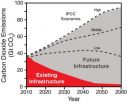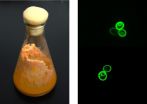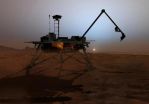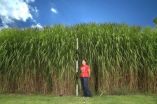(Press-News.org) Bowerbird males are well known for making elaborate constructions, lavished with decorative objects, to impress and attract their mates. Now, researchers reporting online on September 9 in Current Biology, a Cell Press journal, have identified a completely new dimension to these showy structures in great bowerbirds. The birds create a staged scene, only visible from the point of view of their female audience, by placing pebbles, bones, and shells around their courts in a very special way that can make objects (or a bowerbird male) appear larger or smaller than they really are.
"Great bowerbirds are the first known animals besides humans who create a scene with altered visual perspective for viewing by other individuals," said John Endler of Deakin University in Australia. (He says the same principle is commonly used to make structures or scenes of buildings, gardens, or amusement parks appear larger than they are; bowerbirds appear to use it for the reverse effect, to make a scene appear smaller than it is.)
The effect only works from one viewing angle. Great bowerbirds ensure that females will see their courts from one particular spot by constructing an avenue—two rows of tightly packed sticks with a stick floor—that opens onto a court. That court is essentially a stage where the male displays for females.
Endler noticed something that had apparently been missed before, in part, he suspects, because no one had considered the females' viewpoint before. The great bowerbirds line their courts with objects whose absolute size increases with distance from the avenue entrance and the female viewers.
That makes the sizes of things appear to be more regular, a feature that might be aesthetically appealing to the birds and might also help the males to stand out. But there might be another advantage. Assuming the birds see things essentially the same way we do, that forced perspective could lead females to "perceive the court as smaller than it is and therefore perhaps perceive the male as larger than he is," Endler suggested.
Experimental manipulation of the courts by the researchers showed how important that geometrical pattern must be to the males. "When we reversed the gradient—putting smaller objects further away and larger objects closer to the avenue– the birds put the gradient back in three days."
Endler said it isn't yet completely clear why the males do this. Other aspects of bower decoration have been shown to influence mating success, and it is possible that the quality of the forced perspective may be yet another way that females pick a winner. The researchers are now conducting experiments using motion-activated video cameras to test whether the size gradients are related to mating success.
It's also not clear how mentally challenging it really is for the birds to manage this feat. The males might get things placed just right through trial and error. But they may actually have a direct sense of perspective and "know" to put small objects close and larger objects further away, Endler says. That's something else the researchers intend to tease out through further investigation.
And that brings Endler to one last big question, whose answer is problematic even when one is talking about humans: Is it art?
For Endler, the answer is yes. "Visual art can be defined as the creation of an external visual pattern by one individual in order to influence the behavior of others, and an artistic sense is the ability to create art," he says. "Influencing behavior can range from attraction to and voluntary viewing of the art by others to viewers mating with the artist; this is what bowerbirds do. Our definition equates art with conventional signals that are not part of the artist's body. In this sense, bowerbirds are artists and their viewers judge the art, implying an aesthetic sense in birds."
###
The authors include John A. Endler, Deakin University at Waurn Ponds, Geelong, Australia, James Cook University, Smithfield, Australia; Lorna C. Endler, Deakin University at Waurn Ponds, Geelong, Australia; and Natalie R. Doerr, James Cook University, Smithfield, Australia, University of California Santa Barbara, Santa Barbara, CA.
In attracting mates, male bowerbirds appear to rely on special optical effect
2010-09-09
ELSE PRESS RELEASES FROM THIS DATE:
Mental maturity scan tracks brain development
2010-09-09
Five minutes in a scanner can reveal how far a child's brain has come along the path from childhood to maturity and potentially shed light on a range of psychological and developmental disorders, scientists at Washington University School of Medicine in St. Louis have shown.
Researchers assert this week in Science that their study proves brain imaging data can offer more extensive help in tracking aberrant brain development.
"Pediatricians regularly plot where their patients are in terms of height, weight and other measures, and then match these up to standardized curves ...
Main climate threat from CO2 sources yet to be built
2010-09-09
Stanford, CA— Scientists have warned that avoiding dangerous climate change this century will require steep cuts in carbon dioxide emissions. New energy-efficient or carbon-free technologies can help, but what about the power plants, cars, trucks, and other fossil-fuel-burning devices already in operation? Unless forced into early retirement, they will emit carbon dioxide into the atmosphere for decades to come. Will their emissions push carbon dioxide levels beyond prescribed limits, regardless of what we build next? Is there already too much inertia in the system to curb ...
Study finds the effects of population aging have been exaggerated
2010-09-09
Laxenburg, Austria – 9th September 2010. Due to increasing life-spans and improved health many populations are 'aging' more slowly than conventional measures indicate.
In a new study, to be published in Science, (10 September) scientists from the International Institute for Applied Systems Analysis (IIASA) in Austria, Stony Brook University, US, (SBU), and the Vienna Institute of Demography (VID) have developed new measures of aging that take changes in disability status and longevity into account.
The results give policymakers faced with growing numbers of elderly ...
Energy technologies not enough to sufficiently reduce carbon emissions, NYU's Hoffert concludes
2010-09-09
Current energy technologies are not enough to reduce carbon emissions to a level needed to lower the risks associated with climate change, New York University physicist Martin Hoffert concludes in an essay in the latest issue of the journal Science.
Many scientists have determined that in order to avoid the risks brought about by climate change, steps must be taken to prevent the mean global temperature from rising by more than 2°C above pre-industrial levels. Current climate models indicate that achieving this goal will require limiting atmospheric carbon dioxide (CO2) ...
In order to save biodiversity society's behavior must change, leading conservationists warn
2010-09-09
An innovative grouping of conservation scientists and practitioners have come together to advocate a fundamental shift in the way we view biodiversity. In their paper, which was published today in the journal Science, they argue that unless people recognise the link between their consumption choices and biodiversity loss, the diversity of life on Earth will continue to decline.
Dr Mike Rands, Director of the Cambridge Conservation Initiative and lead author of the paper, said: "Despite increasing worldwide conservation efforts, biodiversity continues to decline. If ...
Global health vs. global wealth: Looming choice for health firms in developing countries
2010-09-09
The lure of greater profits elsewhere in the world may divert bio-pharmaceutical firms in developing countries from the creation and distribution of affordable drugs, vaccines and diagnostics for illnesses of local concern, undermining the health prospects of millions of poor people, experts warn.
And they call for a series of measures to bolster international support for continuing the success of firms finding homegrown solutions to immediate health concerns in developing countries.
In a commentary published by the journal Nature Biotechnology, researchers Rahim Rezaie ...
Researchers expand yeast's sugary diet to include plant fiber
2010-09-09
University of California, Berkeley, researchers have taken genes from grass-eating fungi and stuffed them into yeast, creating strains that produce alcohol from tough plant material – cellulose – that normal yeast can't digest.
The feat could be a boon for the biofuels industry, which is struggling to make cellulosic ethanol – ethanol from plant fiber, not just cornstarch or sugar – economically feasible.
"By adding these genes to yeast, we have created strains that grow better on plant material than does wild yeast, which eats only glucose or sucrose," said Jamie Cate, ...
Greener pastures and better breeds could reduce carbon 'hoofprint'
2010-09-09
NAIROBI (9 September 2010)—Greenhouse gas emissions caused by livestock operations in tropical countries—a major contributor to climate change—could be cut significantly by changing diets and breeds and improving degraded lands, according to a new study published this week in the U.S. Proceedings of the National Academy of Sciences. And as an added bonus, scientists found the small changes in production practices could provide a big payoff by providing poor farmers with up to US$1.3 billion annually in payments for carbon offsets.
"These technologically straightforward ...
Phoenix Mars Lander finds surprises about red planet's watery past
2010-09-09
Liquid water has interacted with the Martian surface throughout Mars' history, measurements by NASA's Phoenix Mars Lander suggest.
The findings, published in the Sept. 10 issue of the journal Science, also suggest that liquid water has primarily existed at temperatures near freezing, implying hydrothermal systems similar to Yellowstone's hot springs on Earth have been rare on Mars throughout its history.
These surprising results come from measurements Phoenix made in 2008 of stable isotopes of carbon and oxygen in the carbon dioxide of the Martian atmosphere. Isotopes ...
The pros and cons of Miscanthus -- uses more water, leaches less nitrogen
2010-09-09
URBANA – In the search for the perfect crop for biofuel production, Miscanthus has become the darling to many. But in an effort to not be charmed by its enormous potential for biomass production, researchers at the University of Illinois are taking a careful look at the pros and cons of its behavior in the field.
A recent study analyzed water quantity and quality in plots of Miscanthus, switchgrass, corn, and soybeans and found that Miscanthus used substantially more water, but reduced the potential for nitrogen pollution to water bodies.
"We found that Miscanthus ...




